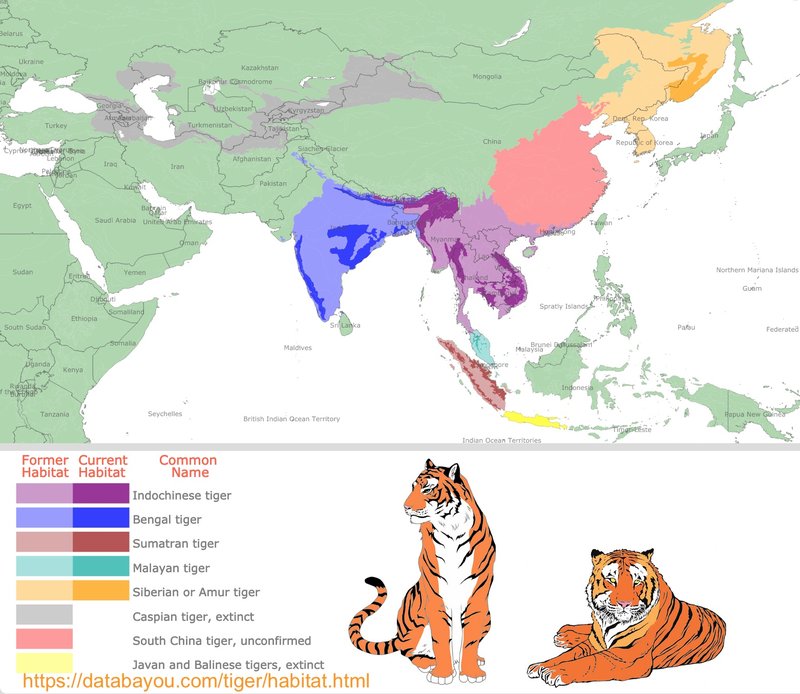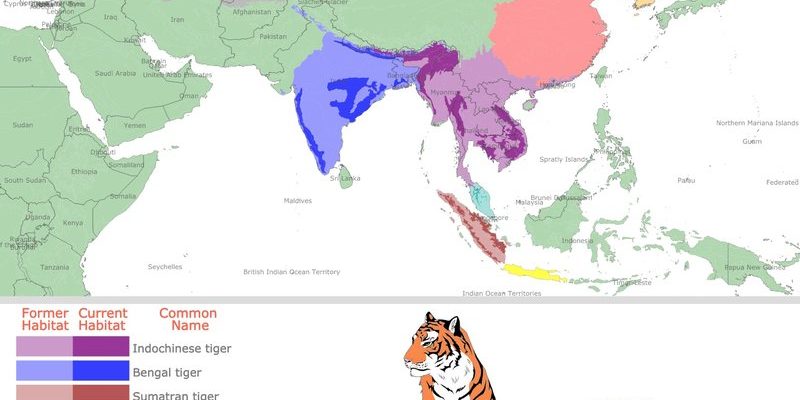
Tigers are adaptable animals, and their habitats reflect that versatility. From the lush rainforests of Southeast Asia to the cold, snowy landscapes of Siberia, these big cats are surprisingly flexible. If you’re curious about what makes a tiger’s home suitable or how their different habitats affect their survival, you’re in the right place. Let me explain how each environment shapes the life of a tiger and what that means for their conservation.
Understanding Tiger Habitats
Tigers thrive in various habitats, and their living spaces can significantly differ based on the subspecies. Generally speaking, tigers are found in forests, grasslands, swamps, and mangroves. Each of these areas offers unique resources that tigers need for hunting, breeding, and raising their young.
In the forests, tigers benefit from the dense cover, which helps them stalk prey. The tall grasses and shrubs in grasslands provide them with good camouflage. Wetlands and swamps give them access to different animals, like deer and wild boar, and mangroves offer a distinct setting along coastlines. Honestly, each habitat is like a unique puzzle piece that fits into the larger picture of tiger conservation.
You might be wondering why such diversity is crucial. The more types of habitats available, the more tigers can adapt to changing environments. This adaptability is vital, especially as human activities increasingly encroach on their territories.
Where Do Tigers Live Globally?
Tigers are spread across different parts of the world, primarily in Asia. Their range spans over 13 countries, including India, Bangladesh, Nepal, Bhutan, Myanmar, Thailand, Laos, Cambodia, Vietnam, Malaysia, China, Russia, and Indonesia. Each country presents its own unique environment and challenges.
India is home to approximately 70% of the world’s tiger population. The vast forests of India, especially in national parks such as Ranthambore and Jim Corbett, provide refuge and breeding grounds. In contrast, Siberian tigers (or Amur tigers) inhabit the cold, temperate forests of Russia. These tigers have thicker fur and a larger body size, adapting to the harsher climate.
This global distribution highlights how tigers have evolved to thrive in various ecosystems. Yet this diversity also brings challenges—habitat loss, poaching, and climate change threaten their populations in every corner of the world.
The Role of Tropical Forests
Let’s dive deeper into the role of tropical forests in the lives of tigers. These lush environments are the primary habitat for many tiger subspecies, especially the Bengal tiger. Tropical forests are bursting with biodiversity, offering a rich source of food, including deer, wild pigs, and other prey.
The dense vegetation and varied elevation in tropical forests provide excellent cover for tigers. They can sneak up on their prey without being detected, a skill that’s crucial for a successful hunt. Unfortunately, tropical forests are under severe threat from logging and agriculture. Deforestation fragments these habitats, making it harder for tigers to roam and find mates.
Preserving these tropical forests is vital not just for tigers but for all wildlife. When we protect their habitats, we’re also safeguarding the intricate web of life that exists in these ecosystems.
Grasslands and Their Importance
Now, let’s look at grasslands. These open areas may seem less exciting than dense forests, but they play a crucial role for certain tiger populations. In regions like India’s Terai grasslands and parts of Southeast Asia, tigers have adapted to hunting in these more open spaces.
Grasslands support a different set of prey animals, such as various deer species. Tigers can utilize their speed and agility to chase down these animals, which thrive in open areas. However, grasslands also face significant threats from agricultural expansion. As farming develops, tiger habitats shrink, pushing these majestic cats closer to human settlements.
Maintaining healthy grasslands is essential for keeping the tiger population stable. Conservation efforts often focus on how to balance land use for farming with the needs of wildlife. Here’s the thing—when tigers thrive, it indicates that the ecosystem as a whole is healthy.
Swamps and Mangroves: Unique Habitats
It might surprise you to learn that tigers don’t just live in forests and grasslands. Swamps and mangrove forests are also crucial habitats for certain tiger populations. The Sundarbans, located in India and Bangladesh, is one famous example where tigers have adapted to a unique coastal ecosystem.
In these regions, tigers are skilled swimmers, able to navigate through water and hunt for prey like fish and crabs. Mangroves offer a unique set of challenges, such as navigating through thick, tangled roots. Yet, for the tigers that live here, it provides a rich hunting ground.
Unfortunately, this habitat faces threats from rising sea levels due to climate change. Mangrove loss affects not only tigers but also countless other species. Conservation efforts here are focused on protecting these vital ecosystems and the unique life they support.
Urbanization and Its Effects on Tiger Distribution
As cities grow and urban areas expand, the impact on tiger habitats is significant. Urbanization disrupts the natural balance in ecosystems. Tigers, who are already facing challenges from habitat loss, find it increasingly difficult to roam freely. Roads, buildings, and agriculture replace the forests and grasslands they once called home.
You might think that urban spaces have little effect on wildlife, but that’s far from true. When humans encroach on these habitats, animals like tigers can end up in conflict with people. This can lead to tragic outcomes for both parties. Tigers may wander into populated areas in search of food, leading to dangerous situations.
Understanding the impact of urbanization is crucial for developing effective conservation strategies. It’s about finding a way for both tigers and humans to coexist peacefully.
The Future of Tiger Habitats
Looking ahead, the future of tiger habitats hangs in the balance. With ongoing conservation efforts and global awareness, there’s hope. Many organizations are working hard to protect and restore tiger habitats. This includes creating wildlife corridors that allow tigers to move freely between fragmented spaces.
It’s also essential for local communities to be engaged in conservation efforts. When people understand the value of tigers and their habitats, they’re more likely to protect them. This can be through eco-tourism or community-led conservation initiatives, which can serve as income sources.
Here’s the thing: the fight for tiger survival is a shared responsibility. By protecting their habitats, we’re not just saving tigers, but also maintaining the balance of nature.
In conclusion, understanding where tigers live is crucial for their survival. From tropical forests to coastal mangroves, these habitats provide essential resources for these magnificent creatures. As we work together to protect them, we ensure that future generations will also know the roar of a tiger in the wild, a sound that should echo through our forests for years to come.

